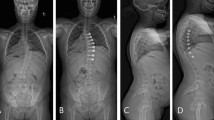Abstract
Study Design
The accuracy and repeatability of a novel sagittal spine length (SSL) radiographic measurement was examined using photographic and radiographic imaging.
Objectives
To validate the new SSL technique for measuring growth in early-onset scoliosis (EOS) patients.
Summary of Background Data
Current assessment of patient growth undergoing growth-friendly surgical treatment for EOS is the use of serial vertical spine height measurements (VH) on coronal radiographs. Spine-based distraction implants are able to control the coronal plane deformity of scoliosis, but exhibit a “law of diminishing returns” in the impact of each follow-up lengthening surgery. As these treatments are kyphogenic, we hypothesize that the increase in kyphosis is, in fact, growth out of plane, not captured by standard spine height measurements.
Methods
Measurement accuracy was assessed using 6 spine model alignments and clinical radiographs of 23 retrospective EOS patients. Inter- and intrarater reliabilities were assessed using interclass coefficient (ICC) analyses. The discrepancy between the VH and SSL was also investigated.
Results
The model assessment showed excellent accuracy, with a 1.54 mm (SD: 1.07, range: 0.03–3.14, p =.226) mean error and mean ICCs of 0.999. As the kyphosis increased, a progressive difference between the phantom VH and SSL was observed. Interrater reliability ICCs of the clinical radiographs averaged 0.981 and 0.804, whereas intrarater reliabilities averaged 0.966 and 0.826, for the coronal and sagittal radiographs, respectively. Mean clinical SSLs were 177.5 mm (SD: 28.5, range: 114.3–250.3), whereas the VH averaged 161.6 mm (SD: 31.8, range: 58.5–243.0), resulting in a 16.0-mm (SD: 16.7, range: 0.3–90.3, p <.0001) difference between the two measurements with a progressive difference as the kyphosis increased.
Conclusions
The novel SSL measurement is accurate, repeatable, and complements the current growth assessments for EOS treatments. Until sagittal spine lengths are taken into consideration, the “law of diminishing returns” should be interpreted with caution.
Level of Evidence
Level II — Prospective Comparative Study.
Similar content being viewed by others
References
El-Hawary R, Akbarnia BA. Early onset scoliosis—time for consensus. Spine Deform 2015;3:105–6.
Skaggs DL, Guillaume T, El-Hawary R, et al. Early onset scoliosis consensus statement, SRS Growing Spine Committee, 2015. Spine Deform 2015;3:107.
Williams BA, Matsumoto H, McCalla DJ, et al. Development and initial validation of the Classification of Early-Onset Scoliosis (C-EOS). J Bone Joint Surg Am 2014;96:1359–67.
Dimeglio A. Growth of the spine before age 5 years. J Pediatr Orthop B 1993;1:102–7.
Dimeglio A. Growth in pediatric orthopaedics. J Pediatr Orthop 2001;21:549–55.
El-Hawary R, Samdani A, Wade J, et al; Children’s Spine Study Group. Rib-based distraction surgery maintains total spine growth. J Paediatr Orthop 2015:1-6. Epub ahead of Print.
Sankar WN, Skaggs DL, Yazici M, et al. Lengthening of dual growing rods and the law of diminishing returns. Spine (Phila Pa 1976) 2011;36:806–9.
Fletcher ND, McClung A, Rathjen KE, et al. Serial casting as a delay tactic in the treatment of moderate-to-severe early-onset scoliosis. J Pediatr Orthop 2012;32:664–71.
Shah S, Karatas AF, Dhawale AA, et al. The effect of serial growing rod lengthening on the sagittal profile and pelvic parameters in early-onset scoliosis. Spine (Phila Pa 1976) 2014;39:E1311–7.
Schroerlucke SR, Akbarnia BA, Pawelek JB, et al. How does thoracic kyphosis affect patient outcomes in growing rod surgery? Spine (Phila Pa 1976) 2012;37:1303–9.
Dede O, Motoyama EK, Yang CI, et al. Pulmonary and radiographic outcomes of VEPTR (vertical expandable prosthetic titanium rib) treatment in early-onset scoliosis”. J Bone Joint Surg Am 2014;96:1295–302.
Dreimann M, Hoffmann M, Kossow K, et al. Scoliosis and chest cage deformity measures predicting impairments in pulmonary function: a cross-sectional study of 492 patients with scoliosis to improve the early identification of patients at risk. Spine (Phila Pa 1976) 2014;39:2024–33.
Zeng Y, Chen Z, Ma D, et al. The influence of kyphosis correction surgery on pulmonary function and thoracic volume. Spine (Phila Pa 1976) 2014;39:1777–84.
Author information
Authors and Affiliations
Corresponding author
Additional information
Author disclosures
AJS (grants from Atlantic Canada Opportunities Agency, during the conduct of the study), CKC (none), WEK (none), JKH (grants from Atlantic Canada Opportunities Agency, during the conduct of the study), REH (grants from Atlantic Canada Opportunities Agency, during the conduct of the study; grants, personal fees and other from Depuy Synthes Spine, grants from Medtronic Canada, personal fees from AO Spine, personal fees from Halifax Biomedical Inc., grants from Atlantic Canada Opportunities Agency, grants from CIHR, grants from Tecterra, grants from Canadian Paediatric Spine Society, grants from SRS, grants and other from POSNA, grants from EOS Imaging, grants from OREF, grants from Dalhousie University Department of Surgery, other from Children’s Spine Foundation, outside the submitted work).
This study was reviewed and approved by the research ethics board of the IWK Health Centre on August 19, 2013.
This project was not funded directly by any source. Research staff wages were provided via a grant awarded to the IWK by the Atlantic Canada Opportunities Agency (ACOA).
Rights and permissions
About this article
Cite this article
Spurway, A.J., Chukwunyerenwa, C.K., Kishta, W.E. et al. Sagittal Spine Length Measurement: A Novel Technique to Assess Growth of the Spine. Spine Deform 4, 331–337 (2016). https://doi.org/10.1016/j.jspd.2016.03.002
Received:
Revised:
Accepted:
Published:
Issue Date:
DOI: https://doi.org/10.1016/j.jspd.2016.03.002




